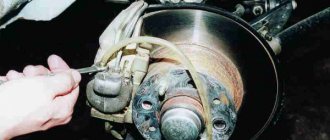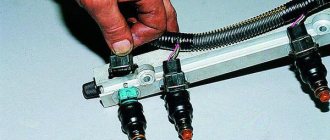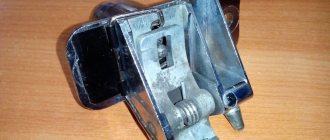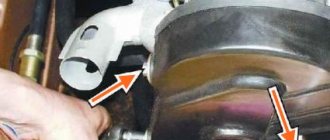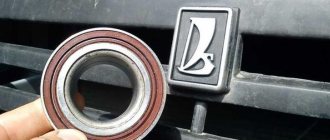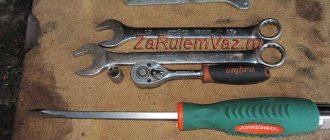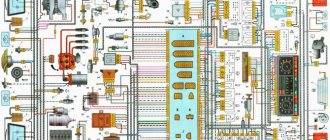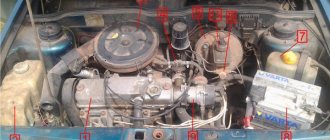Fork
The main reason for poor braking is the primitive damper fork, which cannot consistently press the wheel to the asphalt and effectively handle bumps. On poor surfaces or during impulse braking, the fork sways and does not allow intensive braking. It is with the fork that it makes sense to start upgrading the brakes. Even a standard braking system will perform better with a progressive fork.
The cheapest way is to install a RaceTech valve/emulator in each chainstay. This valve has slow and adjustable fast compression. The disadvantage of this setup is that there are no operational adjustments (you have to do partial disassembly to change the fast compression), and also that all parameters are dependent, and rebound can only be adjusted by oil viscosity, which also affects compression.
The best option in terms of price/quality is to install adjustable cartridges with valves in standard fork legs. That's what we did in the video. This solution allows you to get an effective technological fork at a minimal price.
A complete replacement of the fork, for example, with the KYB 43mm from the FJR1300, is very expensive, because for it you need to change the traverses and the wheel axle. It makes sense to change the entire fork during a comprehensive upgrade with the installation of wheels for 120/70 tires, a double-disc brake system and a set of traverses with an increased spread of stays.
Which brakes are better: rim or disc?
Rim brakes
All rim brakes have a common disadvantage: the wheel rim is damaged during braking. In case of severe damage, when the wheel is twisted into a “figure eight” or “egg”, it is almost impossible to use the brake. Also, in rainy weather, braking is uncertain, due to the wetness of the pads and wheel rim. It is necessary to constantly monitor and adjust the brake as the pads wear.
For one reason or another, in fact, brakes have become a very important safety component and have undoubtedly contributed, on their part, to gaining confidence in the bicycle, which is and remains the ideal car of the leg. This is the oldest of all, and we find it on many historic bicycles that are still loved and in circulation, where a rubber tampon can be found today. The wand control system sent the swab back onto the cap. The handlebar handle was very large to provide the necessary crushing force.
Clearly this was a vibration-free system for the dentin shape of the cap. In addition to avoiding the pushrod rolling, it was usually very thick. This was used with caution, it wasn't really possible to modulate the braking, and even if you didn't help with a fixed shot counter, you could end up capsized. The advent of a free wheel, which made it possible to descend at high speed, he abandoned this decision.
However, rim brakes are successful and are very often installed as they have a number of advantages such as ease of maintenance, affordability, as well as low weight and parts compatibility.
Mechanical rim brakes include pliers and cantilever brakes. Plier brakes consist of pads that are attached to arched levers; when braking, they compress the wheel rim, thereby reducing its rotation speed. The brake cable operates the levers and is conveniently attached to the handlebar handle. The advantage is that clamp brakes are widely available and easy to use. The disadvantages are that such brakes often warp, creating unnecessary friction on the rim, quickly become dirty and have mediocre modulation.
Forget about the front buckle for the above reasons, the reverse counterweight system however still lives on in some urban models today. This is essentially a mechanical system that sits inside the rear hub and works with the pedals. The advantage is that the entire system is protected from water and dirt and is therefore still preferred in Northern European cities. The downside is that it is not modular and is difficult to write down if you start to get unbridled.
The drum brake is a real revolution. This has been happening directly since the birth of the automobile market. It is replaced by a rotating cylinder and one or more strains of friction material. These inner straits, controlled by the brake levers, expand to provide the necessary friction against the outer wall, thus braking. This is definitely a very powerful braking system, comparable to disc brakes. Very modulated and once it is released it creates no friction.
Cantilever brakes are very common to see on mountain bikes. The operation of the cantilever braking system is very simple: two levers with pads are secured to the fork using two special fasteners. When you press the brake handle on the steering wheel, the cable begins to pull these levers towards each other, thus pressing them against the rim, creating friction and braking of the wheel. The main advantage of this type of brake is the complete absence of the possibility of clogging the brake system with dirt.
In addition, the jaws inside the concentrator are not dirty and require no maintenance. Replace the jaws, but it's not like changing the pads to discs or cantilever boots. The main disadvantage of this system, which greatly affects its reliability, is the inability to disperse temperatures. Very often this problem ends in deformation of the brake system due to a decrease in braking force. To this end, today, when they are discovered, they are installed only on the rear wheel, which is the least stressed.
Hydraulic brakes differ from mechanical brakes in that there are no levers that are attached to the pads, as well as a cable system that operates the levers. The principle of operation of the hydraulic system is quite simple: a handle with a master brake cylinder is attached to the handlebars; when pressed, pressure is transmitted to other brake cylinders attached to the bicycle fork. The created pressure forces the brake pads to move towards the wheel rim, which leads to braking. It is worth noting that such a braking system is very effective and is often used in trials. However, hydraulic brakes are heavy, difficult to maintain, and difficult to repair while camping.
The release of the free wheel and the need to simplify the braking system, even in terms of lightness and reliability, led to such braking at the front and rear. The two control levers are located on two separate pins located on the chassis. The levers are actuated by a split cable, which in turn is attached to a control cable located perpendicular to the triangle that houses the split cable. The shoe compresses directly against the wheel rim, causing braking.
Compared to the other systems shown, it is excellent, efficient and quite powerful. This is a system that poses a risk of not hiding. If the control wire breaks, the broken cable falling onto the wheel may lock the wheel. To overcome this danger, the pin that supports the beacon or reflector is inserted at the time under the split cable. The second limit is the low rise of the skates, which makes it a little more difficult. Also like all ski brakes, forcing it to rub along the edge will ruin it, especially if the wheels and skates disappear.
You should also pay attention to V-brake brakes, which are popular and widely used recently. In appearance they are very similar to cantilever ones, but they have a significant difference in the principle of operation. Due to the specific attachment of the cable to the levers, the braking power of the bicycle increases. They are easy to maintain and reliable, also light in weight and thanks to the system of parallel supply of pads to the wheel, they wear out evenly and contribute to better braking. When purchasing a bicycle, you need to make sure that the brakes are adjusted, and then regularly check their serviceability.
The broken circle also wears shoes quickly. In short, it needs to be kept very well controlled and sometimes you can change the circles. However, checking the brake is easy: it is easy to see. It basically works like the console one shown above. It has all the disadvantages and advantages of the above-mentioned brake, and not the serious defect that we have highlighted. If the control cable breaks, the split cable does not fall onto the wheel.
This is why it has been preferred many times for road bikes. Roller brakes are an evolution of the cantilever described above with the elimination of the branched cable. This type is also mounted on two independent plugs. It also has the advantage of eliminating dangerous cable, the arms are moved by a molded plate which is moved directly by the cable which falls perpendicularly. Ease of control has defects in each brake that presses on the rims.
As for drum or roller brakes, they are located directly inside the hub itself in the wheel, motionless, and when braking, they are pressed against the rotating part, reducing speed. Such brakes are quite simple and are not afraid of dirt or dust. However, in case of malfunction, they are very difficult to repair and are heavy, so they are rarely used on hikes.
This system, which improves on the cantilever, also relies on two separate and independent forks per fork, but differs from a single cable that moves both arms. This cable pulls the rod horizontally by pulling two brakes as a clamp. The power exerted is remarkable and it is able to function normally even in the presence of water and dirt. The entry is light and wide, so you can also mount oversized boots, and is distinguished by the ease with which it can be released from the wheel in the case of one.
For this reason, it replaces the cantilever in non-specialized bicycles. When you enter this industry, we see unprecedented and costly solutions. Sometimes it is also dangerous to use materials that are very unsuitable for rain. This type of single spring requirement is mounted on a single center rod, allowing it to have perfect action on both arms without the need for a double cable or spacer plate. The adjustment is made directly on the brake levers and is very useful when restoring braking due to normal brake wear.
Disc brakes
This type of brake has recently become more and more common and practical for bicycles. Disc brakes are simple in structure. They consist of a disc that attaches to the wheel hub, a caliper that attaches to the fork or frame, and a cable (mechanical system) or hydraulic tube (hydraulic system) that connects the caliper to the brake lever.
It is also very easy to adjust the simultaneous contact of the brake pads and their inclination according to the morphology of the circle. However, when the frames are carbon, it is very difficult to brake in case of rain. It's also true that shoes that are good for aluminum are not good for carbon. This is a problem that is difficult to solve, and the industry is deeply involved, even because this problem has already taken its toll.
There is also someone who is not enough to do good things, he also wants her to be very beautiful and do everything to invent something new with something that already exists. In the photo on the left, the models are in evolutionary order on the left. All the problems that arise with shoes described above disappear. The rim is not loaded and braking power, completely independent of the wheels, is applied immediately, even if the rims are wet or dirty or carbonaceous. It's obviously more difficult to handle skis, but only if you don't do it.
When buying a bicycle with a disc brake system, you can be sure of high braking efficiency, you will not need to worry about the condition of the wheel rim, your trips will never depend on weather conditions, they do not require constant maintenance and adjustment, and they have a long service life.
By choosing a bike with a mechanical braking system, you can save a lot on your purchase. The structure of such a system is very simple and looks like a V-break type brake. Here, a simple cable is used to connect the caliper and brake handle. However, you should consider not only the pros, but also the cons. The disadvantage is that the cable can stretch over time, and because of this there is a possibility of the cable getting stuck in the jacket. However, despite this, they are very easy to repair in any conditions, cost less and are well suited for any hiking trips.
They are available with cable control and hydraulic control. The world of cycling is strange. It's a kind of crazy ingenuity and restoration. These materials make traditional brakes completely ineffective. And once the disc was used by professionals, many imitators were sure to adapt.
Here are two examples of companies that have started to think about this. Obviously, they are not even commercial and are considered prototypes. You can use all the materials you want, but the very traditional aesthetic sense of a racing bike enthusiast doesn't allow a disc. Therefore, corrective actions and opinions are possible. The chain is mounted on a chassis bearing, so the bike is a "freewheel". On the other side of the hub you can see the fixed chassis.
If your budget allows, you can purchase a bicycle with a hydraulic braking system.
. Here, braking is performed by transmitting the braking force from the brake handle to the caliper using incompressible brake fluid, which is located in a high-pressure hose. This type of braking system is very effective and has high modulation. A bike with a hydraulic disc braking system is great for professional mountain bikes. But the disadvantages of these brakes should also be taken into account, among which their high cost and difficulty in setting up, which requires special tools and experience, come to the fore.
“What is the difference” between stationary, free and counter-rotating wheels? A flip flop hub is a device that allows a bicycle to run with either a free wheel or a constant click. One is mounted on a ball bearing so it can rotate freely independent of the wheel.
On the other hand, the other chassis does not have a bearing for which it is locked on the hub, i.e. it is tied to the wheel when moving. When the rear wheel is set so that the chain is attached to the chassis to rotate freely, we can keep the pedals stationary and also turn them back while the bike is moving forward. This is the "free wheel" mode typical of all "generic" bicycles.
Finally, it remains to look at bicycles with a hybrid braking system. Such bicycles are very rarely found on sale, because they are expensive and disc mechanics in this case are not much better than other braking systems.
Of the brake systems considered, of course, the most highly effective are hydraulic disc brakes. However, before purchasing, you need to consider the conditions and frequency of use of the bike. And only after that decide what type of braking system you want to deal with, and what of this your budget allows.
This is the "fixed click" mode. The change from "free wheel" to "fixed" mode and vice versa is accomplished by disassembling the wheel and inverting it, and is not believed by some to occur when some kind of gear lever is operated during operation. "Fixed click" is a choice of almost constant driving, it is a way to get pregnant on a bike, not an "alternative" of several minutes as a choice between two different gear ratios.
When the bike moves forward, the pedals always move in the same direction. He brakes by acting on the pedals, that is, sliding down to lock them in order to install a lock on the bicycle. You can also go back. Fixed for clutch purists, remove both brakes on the bike and only use the brake pedals. Others only remove the rear brake because it will overlap with the brake acting on the pedals. There are those who try the first few times and learn, also let the rear brake be installed for safety.
You have no purchases yet
Once upon a time, the choice of a bicycle was limited to the correct height parameters, brand and color. Today the range is so diverse that it is simply impossible to choose even a simple city model without minimal knowledge of the design of modern bikes. In particular, this concerns the variety of braking systems.
Front wheel
The second most important factor is the area of the contact patch and the grip of the front wheel rubber. The standard wheel on the Bonneville T100 is narrow, it is advisable to change it to a wheel with wide 120/70 tires - such tires have a larger contact patch both in a vertical position and in an inclined position. Also, in these sizes there are many more models of tires with different grip and purpose - you can choose a good all-weather road one.
A wide wheel cannot be installed with standard traverses, because they have insufficient feather spread. We need to install new traverses!
In the video, the motorcycle has a non-standard wheel with an 18-inch Kineo disk for 110-wide tires. This wheel is a bit narrow, but we installed the most grippy road tires on it.
Wheels from scratch to V-break bikes
There are not many bicycles on which you can install vibration breaks and discs; the lack of versatility is a significant drawback of rotors. Therefore, switching from rim brakes to disc brakes is not so easy, because you will need to make changes to the design of the bike.
The modification of the brake system concerns the wheel. Its bushing must be “sharpened” for the disk, that is, have special seats for it. This is usually not provided on bikes with v-brake. Here you can go in two ways: put a new wheel with a bushing under the rotor or change only the bushing. The first way is easier:
- you can immediately begin installing the disk;
- there is no risk of assembling the wheel incorrectly (do-it-yourself reassembly);
- You won’t have to spend extra money on installing a new bushing in the workshop.
A quality disc brake kit doesn't come cheap. For the first test, you don’t need to start with two disks - just change the system on the front part. It's possible that the wheels won't live up to your expectations or in practice won't be any better than a V-brake, so it's best to experiment with one wheel.
The procedure for installing a disc brake looks like this:
- Place the caliper on the frame using adapters.
- Screw the brake lever onto the steering wheel.
- Connect the drive lever to the caliper via a drive (cable or hydraulic line) and align its position.
- Attach the rotor to the wheel hub.
- Install the wheel.
The important point is. An incorrectly or not adjusted brake will work ineffectively and interfere with movement.
Since discs are divided into mechanical and hydraulic, it is worth taking a closer look at the installation of both.
Brake system
The brake system is low on the list of changes to improve braking, but it certainly makes a big difference. The difficulty is that the effectiveness of the brakes is limited by the factors listed above, so the brakes need to be selected for a specific setup. There is no point in installing a double-disc brake without a wide wheel or installing a multi-piston caliper with a standard fork.
For the setup in the video, we selected a floating disc and a 6-piston caliper - more about this in a separate article!
We have already implemented the option of a completely custom headset with a 43mm fork, a wide wheel, LSL yokes, a double-disc brake with premium Spiegler components on the SXRacer project. This setup works great, but is very expensive. Now we can say that the option with cartridges is an excellent alternative and the best price/quality ratio!
System composition
As the main safety and stopping system of the machine, it includes the following components and assemblies:
- Master cylinder of the braking system. It represents one of the critical distribution elements between two circuits. From it, steel tubes extend to the distributor to the rear wheels and separately to each front wheel.
- The main brake cylinder consists of a central piston, springs, sealing collars and lining rings are put on it. All this together forms a unit with divided chambers to control the pressure separately in the front and rear wheels. Often malfunctions occur with it in the form of pedal failure, resulting in the absence of brakes at all. The cause of such incidents is most often worn cuffs; less often it is necessary to replace the entire cylinder due to corrosion of the walls.
- Connecting hoses and tubes. The system can use both steel and copper tubes. From the assembly line, cars are equipped with steel ones. Often this is where system malfunctions lie. Due to their corrosion and fairly hard metal structure, they can break if the rear working cylinders are replaced frequently. Then the solution will be to buy more expensive copper ones. They are not subject to corrosion, but they are more fragile, which means careful handling. Although the hoses are used at high pressure, they still become unusable from time to time due to cracking, which naturally leads to fluid leakage. In this case, braking is impossible due to pedal failure.
- The brake mechanism of the front wheels of the VAZ 2107 consists of an ordinary non-ventilated disc, a caliper, two working cylinders (internal and external), a connecting tube between these two cylinders, two guide fingers, pad springs and a bleeder fitting. The caliper is fixed motionless, therefore, if one of the cylinders fails or, in general, wedges, due to one-sided pressure, the disk is deformed, as a result of which this can lead to its malfunction. This also increases wear on the wheel bearings. Therefore, it is necessary to regularly check the performance of both cylinders. Often, when something jams, it can be worked out mechanically by simply pressing on it with a pry bar or a large screwdriver and pressing the pedal.
- The rear wheel braking mechanism consists of a drum, shoes, a hand brake drive, a working cylinder, a spacer bar and two tension springs that ensure the reverse movement of the shoes and their fastening. The rear wheel system is also equipped with a pressure regulator designed as a splitter. It is located on the rear axle.
- Often malfunctions occur with the working brake cylinders. This may manifest itself in their jamming or leaking. If possible, they should be replaced with new ones, but if the mirror surface is still in excellent condition, then you can replace the cuffs, which are quite easily removed from it.
- The brake system drive on a VAZ 2107 car consists of a pedal assembly, which is, in other words, a pedal. It is located on the same axis as the clutch pedal, there is also a return spring and a mechanical brake light switch. When pressed, the pedal presses on the rod, which acts on the membrane in the vacuum booster.
- The vacuum booster is designed to increase pressure on the master cylinder drive rod when the engine is running. This occurs due to a vacuum in the second vacuum chamber due to the connection to the crankcase with a hose. If a malfunction occurs with the amplifier, the pedal suddenly becomes stiff or it falls through, as if there is no fluid in the system. It can be eliminated by disassembling the vacuum and replacing the rubber membrane.
Basically, on the domestic VAZ 2107 car they appear in the form of leaks, which can come from any unit or hose. After eliminating it, the system should be pumped to remove any trapped air.
https://youtube.com/watch?v=bt_GKagQAR8
